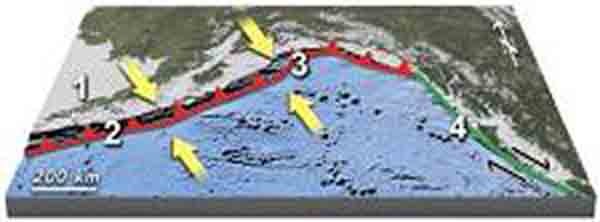Discuss the position of the ITCZ and how it changes with the seasons. What will be an ideal response?
The intertropical convergence zone (ITCZ) is in the equatorial region where the
surface winds of two Hadley cells converge. Strong heating in the ITCZ causes
surface air to expand and rise. The humid, rising, expanding air loses moisture as
rain, some of which contributes to the success of tropical rainforests. Because the
Northern Hemisphere contains much less ocean surface than the Southern
Hemisphere and because landmasses have a lower specific heat than the ocean,
seasonal differences in temperature and cell circulation are more extreme in the north.
Another consequence of the markedly different proportions of land to ocean surface
in the two hemispheres is the position of the ITCZ. The convergence zone does not
coincide with the geographical equator (0° latitude). Instead, it lies at the
meteorological equator (or thermal equator), an irregular imaginary line of thermal
equilibrium between the hemispheres, situated about 5° north of the geographical
equator. The positions of the meteorological equator and the ITCZ generally
coincide. They change with the seasons, moving slightly farther north in the northern
summer and returning toward the equator in the northern winter. Monsoons are linked
to the different specific heats of land and water and to the annual north–south
movement of the ITCZ. The intensity and location of monsoon activity depend on the
position of the ITCZ. The monsoons follow the ITCZ south in the Northern
Hemisphere’s winter and north in its summer.
You might also like to view...
The precipitation conditions in the Sahel are most influenced by the position of:
A) the Polar-Front Jet Stream. B) the Subtropical Jet Stream. C) the Lower Level Jet Stream. D) the Inter-Tropical Convergence Zone.
Which of the following are examples of regulating ecosystem services?
A) Soil formation and nutrient cycles B) Food, water, and fiber C) Pollination and chlorophyll D) Climate, water flow, and disease control E) Aesthetic beauty and recreation
This figure shows plate boundaries south of Alaska. Which location is along a convergent boundary?
A. 1 B. 2 C. 3 D. 4 E. 2 and 3
Without this, the Earth would warm up rapidly due to the absorption of solar radiation.
A. greenhouse effect B. emission of infrared radiation C. atmosphere D. albedo